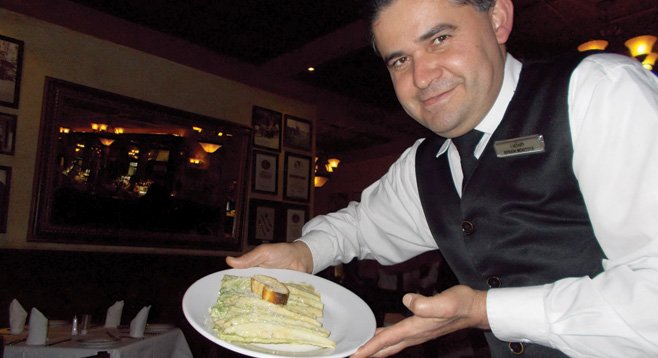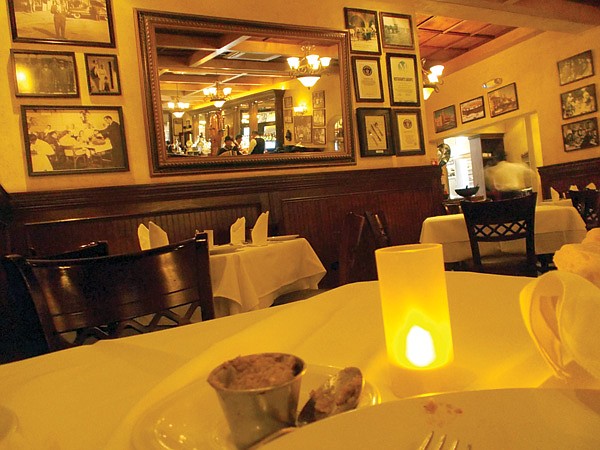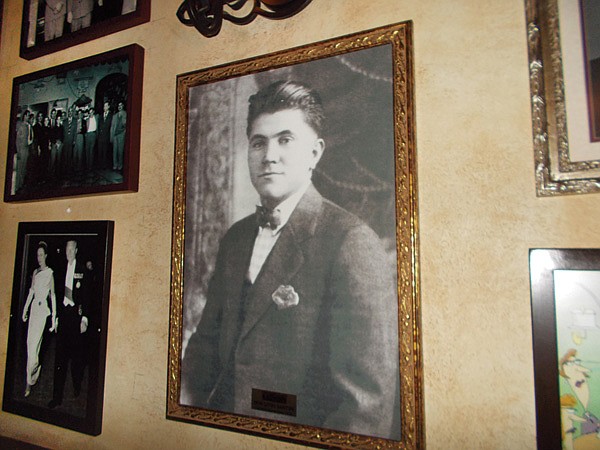 Facebook
Facebook
 X
X
 Instagram
Instagram
 TikTok
TikTok
 Youtube
Youtube

Fires glow orange in the night, down among the bushes along the Tijuana River.
You know what that means: groups of guys caught without papers in the U.S. and dumped back here across the border. In limboland, kinda stateless. No money. No job. No papers to get home to their states down south, either.
Me, I’m on the pedestrian bridge, headed to a little piece of luxury. I swear. That’s Tijuana. Pick your reality. Live with your hypocrisy.
I snake up through the deserted beginnings of Calle Primero, past the wax museum, and up to the giant bicycle-wheel arch, with its twanging support wires.

Five minutes later, I’m sitting at a linen-covered table. An accordionist plays “Arrivederci Roma” while waiters in black waistcoats and long white aprons pad across black-and-white tiles.
This is Caesar’s Restaurant. I’m here because I read that the International Society of Epicures in Paris once (in the 1930s) proclaimed Caesar’s salad to be “the greatest recipe to originate from the Americas in 50 years.”
That got me wondering: How do seven lettuce leaves covered in gunk become a worldwide sensation?
I wait for Efrain Montoya Gaxiola, the waiter, to bring me a menu. Because, basically, I’m carrying 11 buckeroos. That’s it.
Yup, thar she blows — Caesar’s salad, 90 pesos...say, $7.50. Cool. Pretty much everything else on the menu is $15, $30.

I ask if it’s still prepared tableside.
Efrain nods. “Would you like it with chicken?” he asks.
That’s at least a couple of bucks more.
“Uh, no,” I say.
“Would you like something to drink with that?”
Hell, yes. But glasses of wine go for about $6.
“Just a glass of water.”
Jaime Rivera, the acordeonista, is playing “Volare.” Damn, he’s good. It sounds like a love song from Paris. This whole place has a perfect 1930s vibe, from the mirrors to the heavy roof timbers to the giant Russian samovar.
Now Efrain rolls the cart over for the tableside preparation. I know. It’s all a show. But, heck, I like it. The huge wooden bowl, the big wooden mixing paddles... And I like the style of this ensaladero — salad-maker — Efrain, who’s been doing this for at least five years.
He explains the recipe as he works.
“First, you must have chilled romaine lettuce,” he says. “Take the leaves from the inside, top and tail chopped off, because there can be some bitterness there. Put in mustard, grind in some pepper, crush anchovies and garlic, and grate some parmesan. Now you break the egg — coddled, so it’s a little firmer — strain out the white, and drop the yolk in…”
He’s saying all this mainly in Spanish, so I’m concentrating as if it was a Cordon Bleu exam.
“Then you whisk it with these paddles while pouring in the olive oil…until it’s like a paste.”
All the while, the dude’s pouring oil into the bowl from a great height with one hand, whisking the two paddles around with the other.
Now he takes seven romaine leaves and starts sliding them around the bowl till they’re covered in the creamy mess. He lays them out in a row, grates more parmesan over them, and that’s, well, it.
Oh, they have a basket with bread and a little bowl filled with what Efrain says is tapenade, a mix of olives, cream cheese, parmesan, chile morrón, garlic… It tastes delicious on the bread, and also spread onto the big crouton Efrain stuck on top of the salad.
I munch away at all this. By hand. They say César kept the leaves whole so you could hold them in your mitt and crunch down.
“The taste is better that way,” Efrain says.
A tall waiter named Armando Villegas comes to fill my water glass. “It’s the most famous salad in the world,” he says. “And it’s all because of him.”
He gestures behind him at a black-and-white photo on the wall.
“Is that César Cardini?” I ask.
“No. That’s Livio Santini, César’s chef. He was the guy who invented the salad. Or, actually, his mother did.”
Seems Livio’s mom, Beatriz Santini, was Italian, but created this salad in Austria in 1918 to make use of what ingredients she could find during World War I.
Then, one day in Tijuana in 1924, her newly arrived immigrant son, who was working as a chef for César, made up one of these salads as a snack for himself. And then, so the story goes, an American tourist came into the kitchen, took a sample, and liked it so much she ordered a plate of it.
The first enthusiasts were Navy airmen from San Diego — they called the mix “Ensalada del Aviador,” at least in part because César’s brother Alex had been an Italian ace during World War I. Still, six years later, Livio changed it to “Caesar’s salad” to honor his boss.

But how did this little rack of seven leaves become a worldwide phenomenon?
Armando points to the photograph next to Livio’s. “Because of that lady.”
It’s a photo of Mrs. Wallis Simpson, the Duchess of Windsor, walking to some ceremony with the duke at her side. He was England’s King Edward VIII before abdicating the throne so that he could marry her — she was (horrors!) a divorcée.
“They often visited Caesar’s,” says Armando. “And she loved this salad. She went back to Europe and told the whole world about it. She was our best friend.”
Huh. Seven leaves and a duchess. All it took.
As I finish up, I ask myself: Am I full? Well, in addition to the salad, I stuffed plenty of bread down. So I can’t say I’m feeling empty.
Wallet’s okay. Enough change from $10 to leave a decent tip.
Fifteen minutes later, I’m hurrying for the border and the midnight trolley. By 11:30 p.m., I’m back on the lonely pedestrian bridge. I stop for a moment to look out over the riverbed. It’s black down there.
The fires are all out.
Wonder what those guys ate tonight.


Fires glow orange in the night, down among the bushes along the Tijuana River.
You know what that means: groups of guys caught without papers in the U.S. and dumped back here across the border. In limboland, kinda stateless. No money. No job. No papers to get home to their states down south, either.
Me, I’m on the pedestrian bridge, headed to a little piece of luxury. I swear. That’s Tijuana. Pick your reality. Live with your hypocrisy.
I snake up through the deserted beginnings of Calle Primero, past the wax museum, and up to the giant bicycle-wheel arch, with its twanging support wires.

Five minutes later, I’m sitting at a linen-covered table. An accordionist plays “Arrivederci Roma” while waiters in black waistcoats and long white aprons pad across black-and-white tiles.
This is Caesar’s Restaurant. I’m here because I read that the International Society of Epicures in Paris once (in the 1930s) proclaimed Caesar’s salad to be “the greatest recipe to originate from the Americas in 50 years.”
That got me wondering: How do seven lettuce leaves covered in gunk become a worldwide sensation?
I wait for Efrain Montoya Gaxiola, the waiter, to bring me a menu. Because, basically, I’m carrying 11 buckeroos. That’s it.
Yup, thar she blows — Caesar’s salad, 90 pesos...say, $7.50. Cool. Pretty much everything else on the menu is $15, $30.

I ask if it’s still prepared tableside.
Efrain nods. “Would you like it with chicken?” he asks.
That’s at least a couple of bucks more.
“Uh, no,” I say.
“Would you like something to drink with that?”
Hell, yes. But glasses of wine go for about $6.
“Just a glass of water.”
Jaime Rivera, the acordeonista, is playing “Volare.” Damn, he’s good. It sounds like a love song from Paris. This whole place has a perfect 1930s vibe, from the mirrors to the heavy roof timbers to the giant Russian samovar.
Now Efrain rolls the cart over for the tableside preparation. I know. It’s all a show. But, heck, I like it. The huge wooden bowl, the big wooden mixing paddles... And I like the style of this ensaladero — salad-maker — Efrain, who’s been doing this for at least five years.
He explains the recipe as he works.
“First, you must have chilled romaine lettuce,” he says. “Take the leaves from the inside, top and tail chopped off, because there can be some bitterness there. Put in mustard, grind in some pepper, crush anchovies and garlic, and grate some parmesan. Now you break the egg — coddled, so it’s a little firmer — strain out the white, and drop the yolk in…”
He’s saying all this mainly in Spanish, so I’m concentrating as if it was a Cordon Bleu exam.
“Then you whisk it with these paddles while pouring in the olive oil…until it’s like a paste.”
All the while, the dude’s pouring oil into the bowl from a great height with one hand, whisking the two paddles around with the other.
Now he takes seven romaine leaves and starts sliding them around the bowl till they’re covered in the creamy mess. He lays them out in a row, grates more parmesan over them, and that’s, well, it.
Oh, they have a basket with bread and a little bowl filled with what Efrain says is tapenade, a mix of olives, cream cheese, parmesan, chile morrón, garlic… It tastes delicious on the bread, and also spread onto the big crouton Efrain stuck on top of the salad.
I munch away at all this. By hand. They say César kept the leaves whole so you could hold them in your mitt and crunch down.
“The taste is better that way,” Efrain says.
A tall waiter named Armando Villegas comes to fill my water glass. “It’s the most famous salad in the world,” he says. “And it’s all because of him.”
He gestures behind him at a black-and-white photo on the wall.
“Is that César Cardini?” I ask.
“No. That’s Livio Santini, César’s chef. He was the guy who invented the salad. Or, actually, his mother did.”
Seems Livio’s mom, Beatriz Santini, was Italian, but created this salad in Austria in 1918 to make use of what ingredients she could find during World War I.
Then, one day in Tijuana in 1924, her newly arrived immigrant son, who was working as a chef for César, made up one of these salads as a snack for himself. And then, so the story goes, an American tourist came into the kitchen, took a sample, and liked it so much she ordered a plate of it.
The first enthusiasts were Navy airmen from San Diego — they called the mix “Ensalada del Aviador,” at least in part because César’s brother Alex had been an Italian ace during World War I. Still, six years later, Livio changed it to “Caesar’s salad” to honor his boss.

But how did this little rack of seven leaves become a worldwide phenomenon?
Armando points to the photograph next to Livio’s. “Because of that lady.”
It’s a photo of Mrs. Wallis Simpson, the Duchess of Windsor, walking to some ceremony with the duke at her side. He was England’s King Edward VIII before abdicating the throne so that he could marry her — she was (horrors!) a divorcée.
“They often visited Caesar’s,” says Armando. “And she loved this salad. She went back to Europe and told the whole world about it. She was our best friend.”
Huh. Seven leaves and a duchess. All it took.
As I finish up, I ask myself: Am I full? Well, in addition to the salad, I stuffed plenty of bread down. So I can’t say I’m feeling empty.
Wallet’s okay. Enough change from $10 to leave a decent tip.
Fifteen minutes later, I’m hurrying for the border and the midnight trolley. By 11:30 p.m., I’m back on the lonely pedestrian bridge. I stop for a moment to look out over the riverbed. It’s black down there.
The fires are all out.
Wonder what those guys ate tonight.